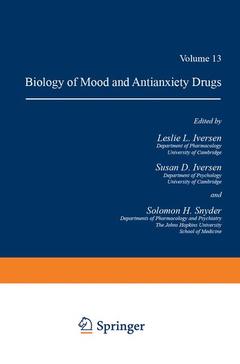Handbook of Psychopharmacology, Softcover reprint of the original 1st ed. 1978 Volume 13 Biology of Mood and Antianxiety Drugs
Langue : Anglais
Coordonnateur : Iversen Leslie

Underlying the design of the Handbook of Psychopharmacology is a prejudice that the study of drug influences on the mind has advanced to a stage where basic research and clinical application truly mesh. These later volumes of the Handbook are structured according to this conception. In certain volumes, groups of drugs are treated as classes with chapters ranging from basic chemistry to clinical application. Other volumes are assembled around topic areas such as anxiety or affective disorders. Thus, besides chapters on individual drug classes, we have included essays addressing broad areas such as "The Limbic-Hypothalamic-Pituitary-Adrenal System and Human Be havior" and "Peptides and the Central Nervous System. " Surveying these diverse contributions, one comes away with a sentiment that, far from being an "applied" science borrowing from fundamental brain chemistry and physiology, psychopharmacology has instead provided basic researchers with the tools and conceptual approaches which now are advancing neurobiology to a central role in modern biology. Especially gratifying is the sense that, while contributing to an understanding of how the brain functions, psychopharmacology is a discipline whose fruits offer genuine help to the mentally ill with promises of escalating benefits in the future. L. L. 1. S. D. 1. S. H. S. vii CONTENTS CHAPTER 1 Peptides and the Central Nervous System ARTHUR]. PRANGE, ]R. , CHARLES B. NEMEROFF, MORRIS A. LIPTON, GEORGE R. BREESE, and IAN C. WILSON 1. Introduction . . . . . . . . . . . . . . . . . . . . . . . . . . . . . . . . . . . . . . . . 1 2. Hypothalamic Releasing Hormones: Animal Studies. . . . . 2 2. 1. Thyrotropin-Releasing Hormone (TRH, Thyroliberin) . . . . . . . . . . . . . . . . . . . . . . . . . . . . . . . . . . .
1 Peptides and the Central Nervous System.- 1. Introduction.- 2. Hypothalamic Releasing Hormones: Animal Studies.- 3. Pituitary Peptide Hormones: Animal Studies.- 4. Other Brain Peptides: Animal Studies.- 5. Hypothalamic Releasing Hormones: Human Studies.- 6. Pituitary Peptide Hormones: Human Studies.- 7. Discussion.- 8. References.- 2 The Limbic-Hypothalamic-Pituitary-Adrenal System and Human Behavior.- 1. Introduction.- 2. Description of the Limbic-Hypothalamic-Pituitary-Adrenal System.- 3. Procedures for Evaluating LHPA Function in Humans.- 4. Relationship between Mental Phenomena and the LHPA System.- 5. Summary.- 6. References.- 3 Approaches to Brain Amines in Psychiatric Patients: A Reevaluation of Cerebrospinal Fluid Studies.- 1. Introduction.- 2. Methodological Considerations for Spinal Fluid Studies.- 3. CSF Amine Metabolites in Affective Illness.- 4. Amine Metabolism in Schizophrenic Patients.- 5. Pharmacological Approaches: Integration with Amine Metabolite Data.- 6. Theoretical Overview: The Question of Specificity.- 7. A Model for Defects in Compensatory and Regulatory Mechanisms.- 8. References.- 4 Amine Hypotheses of Affective Disorders.- 1. Introduction.- 2. Classification of Depressions.- 3. Serotonin Metabolism in Affective Disorders: Study of Peripheral Indicators.- 4. Metabolism of Catecholamines in Affective Disorders: Study of Peripheral Indicators.- 5. Postmortem Study of Central Monoamine Metabolism in Depressions.- 6. Central Monoamine Metabolism in Affective Disorders: CSF Studies Without Probenecid.- 7. Central Monoamine Metabolism in Affective Disorders: CSF Studies After Probenecid Loading.- 8. Verification of the Monoamine Hypothesis with the Aid of Drugs: I. Monoamine Precursors and Synthesis Inhibitors.- 9. Verification of the Monoamine Hypothesis with the Aid of Drugs and Other Methods of Antidepressant Therapy: II. Direct Influencing of the Transmission Process.- 10. Theories to Explain the Monoamine Deficiency in Depressions.- 11. Preliminaries to Expansion of the Monoamine Hypothesis 270 11.1 Acetylcholine.- 12. General Conclusions.- 13. References.- 5 Clinical Pharmacokinetics of Selected Psychotropic Drugs.- 1. Introduction.- 2. Tricyclic Antidepressants.- 3. Lithium.- 4. Benzodiazepines.- 5. CNS Stimulants (Amphetamine).- 6. Chlorpromazine.- 7. Conclusion.- 8. References.- 6 Behavioral Pharmacology of Antianxiety Drugs.- 1. Introduction.- 2. Anticonflict Properties of Antianxiety Agents.- 3. Properties of Antianxiety Agents in Miscellaneous Operant Conditioning Situations.- 4. Properties of Antianxiety Agents in Additional Behavioral Procedures.- 5. Concluding Remarks.- 6. References.- 7 Antianxiety Drugs: Clinical Use in Psychiatry.- 1. Introduction.- 2. Using Drugs to Treat Anxiety.- 3. Improving Specific Symptom Profiles of Anxious Patients.- 4. Predicting Improvement in Anxious Patients.- 5. Conclusion.- 6. References.
Date de parution : 04-2012
Ouvrage de 440 p.
17.8x25.4 cm
Thèmes de Handbook of Psychopharmacology :
Mots-clés :
brain; chemistry; drug; physiology; psychopharmacology; research
© 2024 LAVOISIER S.A.S.



